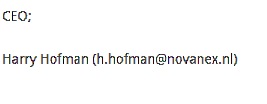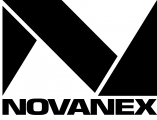Shopping Cart
0 item(s) - €0,00About Us

Photo; Novanex factory in Wychen (NL) till 1994.
Novanex Automation B.V. is a dynamic company employing about 30 young engineers and posesses an extensive research and development facility with state of the art testequipment and design software. Furthermore we operate a production facility including , screen printers, several SMD pick&place machines, reflowoven, CNC-machines, 3D-printers, etc. etc.
The firm has a long history that started in sixties of last century. The original name was Nederlandse EXtrusie Maatschappij N.V. (Dutch Extrusion Company),manufacturer of PVC flooring tiles, by means of (as in the name) extrusion.
The business went really well till the oil-crisis started in 1973. The Netherlands were cut off from oil deliveries from the middle east for some time and the production of tiles came to a grinding halt. That is really a bother when you employ over 100 people. Our CEO. Mr.Robert Laupman did not surrender so easily and quickly looked for other business activities to generate work and turnover. Next to the NEM there was also the sister company AUCON Automation NV., an electronics manufacturer. Here laboratory power supplies, ventilator controls and moisture meters were manufactured. Those meters were used the check the concrete floor for moisture before installing the PVC tiles. A too high moisture content can damage the installed flooring.
Mr. Laupman's son played electric guitar and desperately looking for a product to make, the decision was quickly taken to start manufacturing guitar amplifiers. Just as fast they came up with the name Nova(new)NEX, under which name also the activities of AUCON were from now on marketed. Most important AUCON product was the VI-E2, practically the standard meter for concrete moisture worldwide till its production ended in 1993. The meter was succeeded by the digital version VI-D1, which is still produced. Up till today many tens of thousands of these meters have been produced and sold all over the planet under various brandnames.
Also in the field of audio technology Novanex was an accomplished company. Laupman was a prolific inventor and enriched the company with over 100 patents. A specific cabinet design with 2 drivers with a bassport inbetween was one of them. This invention was extensively used in our loudspeakers and provided a very far carrying and efficient bass. So it was no surprise that those loudspeakers could be often found in discoteques and open air events. Another amazing invention was the TL-tube starter, which made the TL-tube last for eternity. Mr, Laupman was extremely proud to present it to Philips. Well, Philips reaction was unexpected. Fearing total collapse of sales they changed the design of the tubes. Philips changed the design immediately so that they worked again as was intended ( breaking down ).
Another interesting invention was the active tone control which was applied in the DIP-100. The principle behind this invention is the fact that the at various soundlevels the human ear has a different sensitivity over the audible frequency range. A popular solution was for a long time the Loudness-switch, to extra amplify the high and low frequencies at low volume. Laupman built a regulation that could follow over the whole volume range the human frequency sensitvity curve. This resulted in a complex analog circuit. Nowadays we would do that easily with a Digital Signal Processor. Philips was very keen in building such a system into their HIFI-systems expecting to yield an extra 100 Dutch guilder per unit. In the Philips-calculation it meant that only an extra of 2,50 guilders could be spent on components in the amplifier. This was impossible to do for Laupman who basically built a too complex analog processor for it. We still have many DIP-100 (Dynamic Isophonic Processor) amplifiers in stock.
April 1994 the production of most of the audio equipment was stopped although the order position for PA-systems was on an all time high due to its popularity. For the first time in its history The Gitarist published a colour photo of a Novanex product ( Acoustic Guitar Amp AG-70). The design was a shock for the market that never expected such nice design from us. Measuring equipment stayed in production till today without interruption.
Here a part of the Dutch Wikipedia information about Novanex Automation NV ( the predecessor ).;
The company was founded by Robert Laupman and was located at the Nieuweweg in Wijchen. Novanex started end of the seventies out of a hobby and interest in electronics. Certainly in the first years it was a amazing brand because of its very elaborate audio mixers, but mainly because it believed from the start in active loudspeakers. Here the amplifier is built in the cabinet. This principle was kept in nearly all products till the end. In the beginning mostly Philips drivers were used, later also Fane acoustics and IREL drivers ( later also Wharfedale en Beyma ). from the first years also originate the mixers and guitar amps with the big coloured knobs, and the among musicians very well known 50 watts PLM-50n active monitor box with the12 inch dubbelcone driver from Philips.
The logic behind the namegiving of Novanex-loudspeakers is fairly simple. The number refers to the power of the loudspeaker. So the L-100 has 100 WattS, and the L-250, 250 Watts. This is the same for most guitar-, bass-, and keyboard amplifiers; so the straight-hundred 100 watt. But the PG-82 has not 82 Watt ( the 2 stands for 2 chanells Nov.).
Novanex is mainly known for the L-500, a large loudspeaker cabinet with a remarkable appearance; this loudspeaker had 2 15 inch (app. 38 centimeters) drivers with double cone and four kleine high frequency horns (Fostex). This loudspeaker was produced during many years and is still popular with drive-in-discotheques and bands. That Novanex was innovative also with this loudspeaker cabinet shows from the fact that the L-500 contained 3 amplifiers, namely for each 15 inch cone one 200 Watts and for the 4 high frequency horns one of 100 Watts. Those were fed through a built-in active two-way filter.(Source; Wikipedia)

